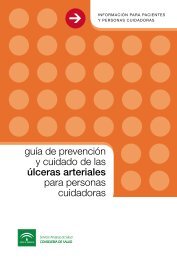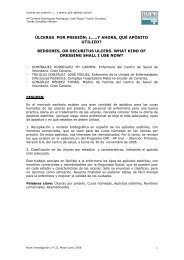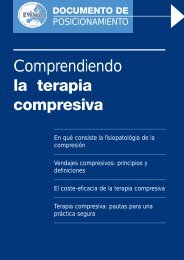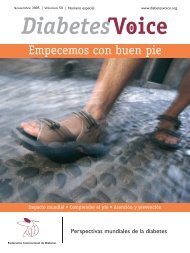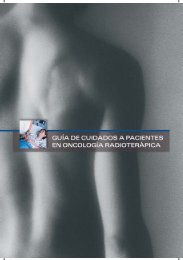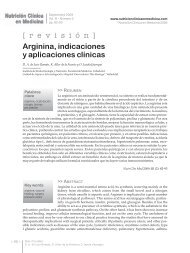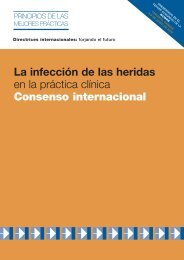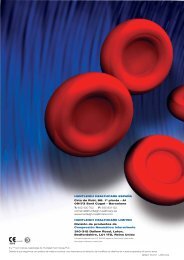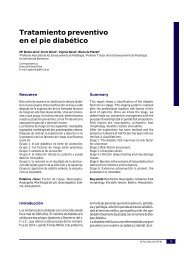Descargar - Úlceras.net
Descargar - Úlceras.net
Descargar - Úlceras.net
- No tags were found...
Create successful ePaper yourself
Turn your PDF publications into a flip-book with our unique Google optimized e-Paper software.
114 ■ PIE DIABÉTICOThe primary goal of treatment for theapplication of NPWT is to progress a woundtowards closure, either by secondary intentionor surgically. Secondary goals are thereduction of the amputation rate, to achievefaster wound bed preparation and to reducethe frequency of dressing changes.According to an expert panel consensus(18) NPWT must be considered as anadvanced wound care therapy for post-ope -rative University of Texas Grade 2 and 3 diaunclear.The first animal study by Morykwaset al. (5) described a maximal increase ofperfusion measured by laser Doppler using125 mmHg negative pressure lasting 5-7minutes, followed by a decrease to baseline.Wackenfors et al. (6) could find an area ofhypoperfusion close to the wound edges(< 1,5 cm), but increased perfusion slightlyaway from the wound border. Increased perfusionremained for 10 minutes, followed by afall to baseline and negative pressure higherthan 50 mmHg led to the enlargement of thearea of hypoperfusion. The author concludedthat lower negative pressures and intermittentmode are required to avoid ischemia.Chen et al. (7) observed an increase in bloodflow in wounds experimentally created in theears of white rabbits and subsequently treatedwith vacuum-assisted closure technology.Microscopic examination and image patternanalysis revealed that increased blood flowseemed to be the result of higher vasculardiameter, blood flow velocity, and blood vo -lume, as well as angiogenesis stimulation andendothelial proliferation. Z ch et al. (8) andKalmoz et al. (9) have also reportedincreased blood flow in diabetic foot ulcersand dermal burn injuries treated withNPWT, respectively.Barrier function and local woundenvironmentThe ability of NPWT to protect thewound depends on its physical ability to providean airtight barrier between the woundand the external environment as a result ofthe integral adhesive drape. This provides adual function; the drape maintains a moistwound environment, conducive to woundhealing, as well as providing a barrier to externalinsult (e.g., contamination by particulatesor microbes). Fleischmann et al. (2) (10, 11)found an effective protection in acute traumaticwounds treated with NPWT. Many referencesreport that NPWT can reduce oedema(4, 13) contributing to increase the bloodflow, although this observation is only basedon clinical observations.Granulation tissue formationand cell proliferationThe formation of granulation tissue is anessential step in wound healing process eitherby reducing wound size, allowing secondaryintention closure, or preparing the woundbed for surgical grafting.The significant increase of granulation tissueformation induced by NPWT was firstreported by Morykwas et al. (4, 13) in a swinemodel and confirmed by Fabian et al. (14) inan ischemic wound model in rabbits. Theanalysis, based on immunohistochemicalmethods of tissue biopsies taken from woundbase and edge before and after 5 days ofNPWT, found a 200% increase in endothelialcell proliferation (15). Another trial describeda significant increase of epithelialization ofsplit thickness skin graft donor sites treatedwith NPWT (16).Wound DeformationUpon application of negative pressure, thewound immediately contracts, reducing itssize (macrodeformation). Application of NPWTwound fillers in the wound bed causesmicrodeformations that are thought to contributeto granulation tissue formation and,thus, to reduce wound size (17).NEGATIVE PRESSURE WOUNDTHERAPY IN FOOT ULCERSDiabetic foot ulcers without ischemia





